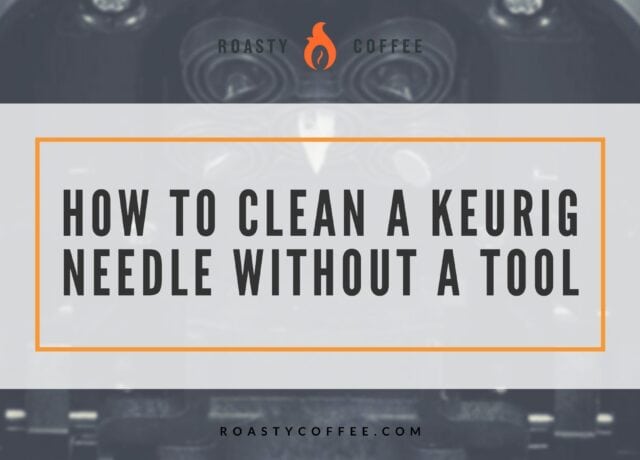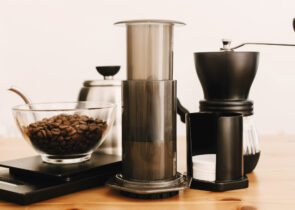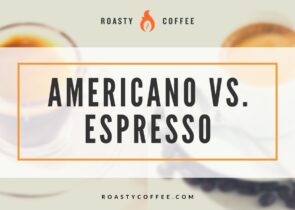Coffee enthusiasts and baristas worldwide know which coffee makers can produce a great cup of espresso. However, coffee newbies may need to research brands and types to get cafe-style results.
Today, we will break down a Brikka vs. Moka comparison to see which of the two espresso presses delivers the goods.
Moka Offers History, Purity, and Espresso
Moka pots take a time-honored approach to brewing coffee on a stovetop. If you are a hands-on type of person, making coffee the old-fashioned way may be especially appealing to you. However, for purists, this imbues the process with a more authentic feel, especially when it comes to espresso.
Moka has three chambers, An upper chamber for the finished espresso, a middle chamber for the grinds, and the one that holds the water used for generating steam on the bottom. Water pushes into the middle chamber, where it mixes with your grind of choice and makes its way to the top.
Bialetti Was a Brilliant Man
The Moka pot was born the way most inventions are, at the crossroads of inspiration and necessity. After observing the physics of his wife doing their laundry in an old-fashioned washing machine, Italian industrialist Alfanso Bialetti envisioned a similar mechanism for making coffee.
Working with fellow inverter Luigi di Pointi, he created a working model of his design for the consumer market by 1933. Before this, the only way anyone could acquire the more decadent Italian coffees of the day would be to visit a coffee bar.
Cafe presses in coffee bars pumped out large quantities of cappuccinos, espressos, and lattes. However, the fact that you could only buy this coffee in a cafe, plus its cost, placed exotic coffee blends out of the reach of the working-class man.
Modern Moka Would Make Bialetti Proud
Since its inception, the Moka pot has evolved into the Moka Express. The variation has altered a bit in size and shape but not as much in the mechanism.
By the time Alfanso’s son, Renato Bialetti, passed on in 2016, both would have lived to see various incarnations of Bialetti pots, including the Brikka coffee maker, grow to global fame and use.
Making the Brikka vs. Moka debate further compelling is the fact that the same masterminds created them both. So, to see which one produces a better espresso, let’s first see how Moka measures up.
Things We Like
The most significant advantage of using a Moka pot is the price difference. As far as espresso makers go, Moka is more economical, with some models going for under $25.
Other benefits of using a Moka pot include:
- Aluminum Moka pots conduct heat very well.
- They produce deliciously small, concentrated cups of coffee.
- Classic design and style, a nod to Moka’s origins.
Things We Don’t Like
Because of its older design, the Bialetti Moka pot is a bit fussy and hard to use. In addition, the learning curve, coupled with monitoring the stovetop brew, makes daily coffee brewing a chore.
- The brew can taste a bit bitter as Mokas tend to over-extract.
- Also, you have to take due care to ensure the pot does not “explode” due to excessive pressure.
- Finally, it can be tough to clean, and you will occasionally have to replace the rubber gasket.
One could say the Moka pot is best suited for making small cups of espresso. However, if you don’t mind the fact it takes some time to brew and clean, Moka could be a winner for you.
Brikka—a Design Perfected
As we get into the nitty-gritty of the Brikka vs. Moka comparative, let’s start with Brikka’s origins.
Like Moka, the Brikka pot was created by the team of Alfonso and Luigi and had a very similar design. In this regard, Brikka is considered an upgrade to Moka in incremental yet significant ways.
Crema Espresso on Demand
Although the two pots look alike, one effective difference is that Brikka espresso makers with pressure valves (aka crema filters) make a layer of crema foam on the espresso. Their dual pressure valve system produces a thicker crema and makes the espresso more enjoyable.
While this is the most marked distinction, there are other critical differences between the Bialetti Brikka and the Moka espresso makers.
Brikka Brews Faster
When it comes to speed, Brikka vs. Moka stats don’t lie. It takes roughly ten minutes to brew a cup of espresso in the classic Moka pot. Brikka is significantly faster, brewing a cup in under three minutes.
Admittedly, the upgraded Moka Express speed of brewing is shorter than the older version, but it still takes roughly four minutes to brew.
Other Things We Like
As mentioned before, Brikka makes a great head of rich crema foam. Many online reviews of the two espresso coffee makers point out this fact.
Other Brikka pros include:
- The coffee is a bit stronger and tastes better. Moka espresso tends to be a bit watery and lacks crema. It can also be bitter due to being over-extracted.
- Brikka is also said to be able to make a tastier latte than Moka.
- Brikka makes fewer cups but extracts more caffeine giving you more bang for your buzz.
What We Did Not Like
Despite the advantages of a Brikka, there are a few drawbacks to using this version of a Bialetti pot.
- Brikka is less commonly used, so the parts can be hard to find.
- Speaking of details, Brikka is just as prone to explode as Moka if you are not careful.
- Consumers often complain about faulty construction, most notably a defective funnel.
The last con is a problem because it leads to lower water pressure, which reduces the production of coffee with crema.
Brikka Is the Cream of the Crop
Because Brikka is the pot Bialetti created to improve his former invention, the Moka, there’s no contest. So, in the Brikka vs. Moka debate, I’d choose Brikka.
Sure, it has a few defects in its design, but so does Moka. All of the key differences boil down to one thing: Brikka gives espresso lovers better crema. It also makes great lattes, provides a more potent dose of caffeine, and the coffee isn’t as watery.
That said, both are classic pots that come in equal-sized models. They would both be at home in your kitchen or on a camping stove. The brewing process is the same, as well. Depending on what you are going for, either one would be an excellent addition to your home cafe arsenal. Have fun experimenting and…
Happy Caffeinating!

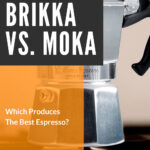
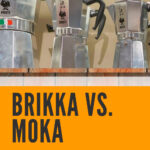
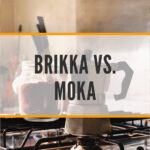
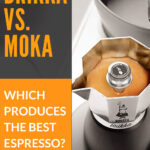

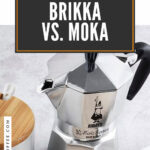
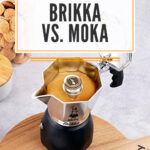
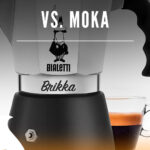
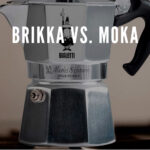
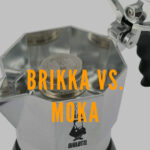

![Brikka vs. Moka: Which Produces The Best Espresso? 14 Bialetti Brikka Aluminium stovetop Coffee Maker (2 Cup) [ New Version ], Silver](https://m.media-amazon.com/images/I/41k+I0WaWfL.jpg)

